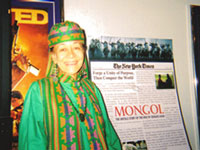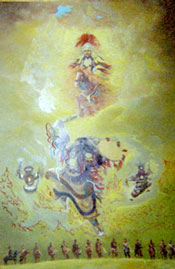By Mother Tynetta Muhammad
“And surely this is a revelation from the Lord of the worlds. The Faithful Spirit has brought it On thy heart that thou mayest be a warner, In plain Arabic language. And surely the same is in the Scriptures of the ancients.” —Holy Qur’an, Surah 26, verses 192-196

Upon my return from the third Mxodus Tour and the African Diaspora in Mexico this past weekend, 26 adventurous travelers took a peek into a new world of reality, which has transformed our lives. Ever expanding our spiritual consciousness, we steadily became aware of other dimensions of time space. Being surrounded by the lush foliage of the tropical rain forest, deeply entrenched in Southern Mexico, we observed a nearly extinct civilization of Mayan survivors and walked side by side with members of the Lacondon community who were our guides and hosts in the state of Chiapas. We ventured into the Lacondon jungle where the profuse sounds of insects and a variety of tropical birds filled the atmosphere.
Beginning from the archaeological site of Palenque, we began our jungle trek passing through rivulets of smaller waterfalls until we reached the greater waterfalls of Golondrios, which means swallows, within a 19-mile radius of the famous painted mural walls of the temple of Bonampak, deep in the Lacondon Forest Reserve. We were made more and more by degree of the linguistic connection between Mayan names and words which contained sounds and spellings equivalent to the Arabic language by also utilizing Mongol names. Unraveling the hidden mystery of the ages, our tour group was stimulated and awe-struck to make these connections. All of us were guided simultaneously to sights and sounds that are very difficult to explain except through the senses to behold a presence existing there beyond our normal comprehension. We recognized as a “group consciousness” that we were not alone. We were literally transported to worlds beyond.
Before going into some of the finer details of this phenomenal journey to Mexico, I wish to focus our immediate attention back to where we left off in our previous article showing the cross-cultural links between Native American societies and the people inhabiting the Steppes of Mongolia. Here in the tropical rain forest of Chiapas. Mexico, further proof prevailed connecting the African and Asian Diaspora from the East to the West from ancient times. Names in the Mayan language such as Chaan (or Khan), and Kin meaning Great Ruler or the Heavens, compare significantly to the Mongol term and meaning for Khan (Great or Universal Ruler).

This title is most revered and respected among the Mongolian and Turkish tribe in Eurasia or Central Asia as it is in Maya Land. We may also look at the word “Kulkukhan,” referring to the great ruler and the folk hero of all Meso-America whose name is Quetzalcoatl, meaning the Feathered Serpent, the symbol for bird and serpent coming together.
Recently a group of believers in Chicago attended the premier showing of the award-winning film, “Mongol,” showing exclusively at one or two theatres in Chicago’s north side. A few in other parts of the country also viewed the film in Columbus, Ohio, Washington, D.C., Phoenix, Arizona and Los Angeles, California. The following previews are attached to this article as further studies are ever advancing showing peculiar similarity between the life of Genghis Khan and the establishment of the Mongol nation to the Nomadic society of the Arab in the time of the rise of Prophet Muhammad, (may the peace and blessings be upon him), and the establishment of Islam in the East. While not withstanding many remarkable similarities between the history of both those epic civilizations to the rise of the Honorable Elijah Muhammad and the Nation of Islam in America established by the Great Mahdi, Master W. Fard Muhammad.
This history is continuing through the powerful representation of the spiritual leadership of the Honorable Minister Louis Farrakhan. The first review and commentary of the movie, “Mongol,” comes to us from Sister Gladys Muhammad of Los Angeles, California:
“I usually shy away from foreign films due to the fact that I’m usuallyget lostwhenreading the subtitles, and unable to focus on the movie at large. However, “Mongol” was such a wonderful historical drama, spoken in Mongolian with English subtitleswhichwerevery easy to read and even easier to focus on the movie. Directed by the award-winning Russian filmmaker, Mr. Sergei Bodrov, this movie dramatically follows the perilous and tough life of a boy named Temudgin, who eventually through hard trials is destined to become the future conqueror and great ruler Genghis Khan. I do love the fact that even with all of the difficult trials and tribulations experienced while being married to Borte (selected during childhood) his wife, this movie portrays how Borte was indeed his lifelong love,advisor, friend and soul mate.
“Thecinematography was spectacular. The beautiful landscapes were poetic and absolutely magnificent.This film was on location in China, Kazakhstan and Mongolia and truly captures breathtaking lands of greatness.The movie depicts the harshness of nomadic life, and Ilearned some of the roles of Mongol traditions and customs from viewing this film.”
“They will not believe in it till they see the painful chastisement; So it will come to them suddenly, while they perceive not; Then they will say: Shall we be respited? Do they still seek to hasten on Our chastisement? —Holy Qur’an, Surah 26, verses 201-204
To be continued.












